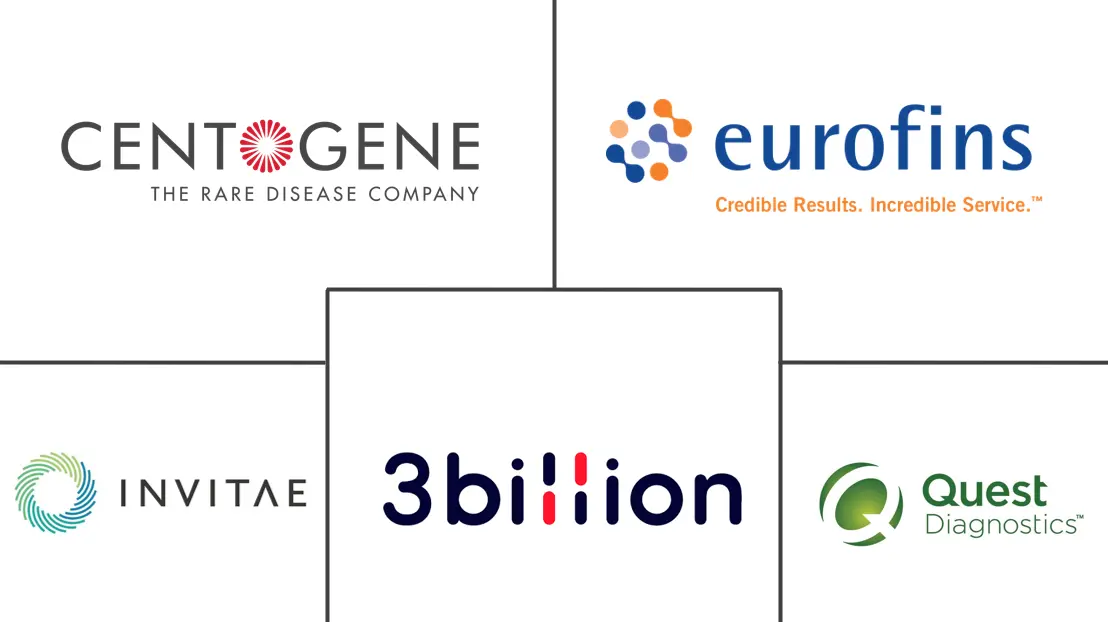Rare Disease Genetic Testing Market Size and Share
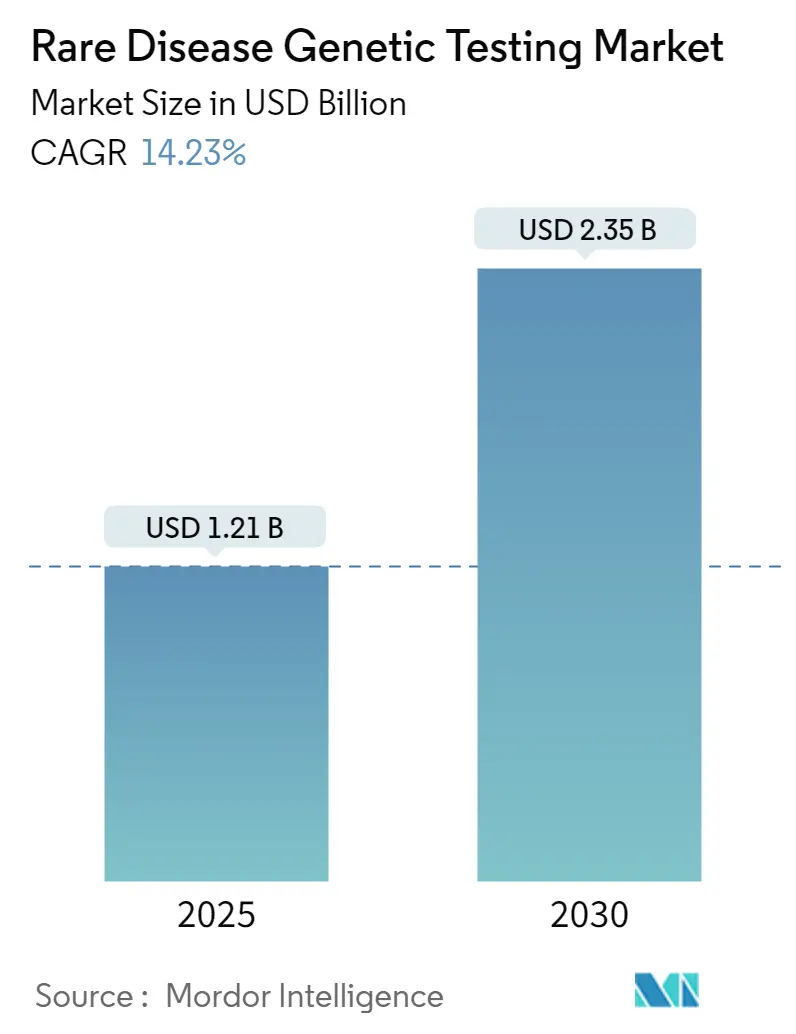
Rare Disease Genetic Testing Market Analysis by Mordor Intelligence
The rare disease genetic testing market size reached USD 1.21 billion in 2025 and is forecast to climb to USD 2.35 billion by 2030, translating into a resilient 14.23% CAGR. Continuous drops in next-generation sequencing (NGS) prices, combined with AI-enabled variant-interpretation engines and wider reimbursement, move genetic testing from niche research toward mainstream clinical care Laboratories now deliver same-day genomic diagnoses, while regulators increasingly classify complex assays as essential medical infrastructure rather than experimental add-ons. Heightened demand also reflects the vibrant pipeline of gene therapies whose prescribing information requires a molecular diagnosis, reinforcing the clinical value proposition of broad-based sequencing.
Key Report Takeaways
By test type, whole-exome sequencing commanded 36.54% of rare disease genetic testing market share in 2024.
By technology, long-read NGS is advancing at a 16.35% CAGR, outpacing short-read platforms already holding 72.34% revenue share.
By sample type, blood retained a 58.46% share of the rare disease genetic testing market size in 2024, yet saliva and buccal swabs are growing 14.89% annually.
By indication, neurological disorders held 31.23% revenue and are projected to accelerate at 16.21% through 2030.
By geography, North America dominated with a 43.23% share in 2024, while Asia-Pacific is projected to expand at 16.45% CAGR to 2030.
Global Rare Disease Genetic Testing Market Trends and Insights
Driver Impact Analysis
| Driver | (~) % Impact on CAGR Forecast | Geographic Relevance | Impact Timeline |
|---|---|---|---|
| Declining cost of next-generation sequencing | +3.2% | Global | Medium term (2-4 years) |
| National reimbursement expansion for rare-disease diagnostics | +2.8% | North America & EU, expanding to APAC | Short term (≤ 2 years) |
| AI-enhanced variant-interpretation platforms | +2.1% | Global, with early adoption in North America & EU | Medium term (2-4 years) |
| Biopharma trial recruitment via rare-disease gene databases | +1.9% | Global, concentrated in North America & EU | Long term (≥ 4 years) |
| Newborn genomic-screening pilots | +1.7% | North America, UK, expanding globally | Long term (≥ 4 years) |
| Portable long-read sequencers in emerging markets | +1.4% | APAC, Latin America, MEA | Long term (≥ 4 years) |
| Source: Mordor Intelligence | |||
Declining Cost of Next-Generation Sequencing
NGS reagent and instrument costs fell sharply, pushing whole-genome sequencing below USD 600 per sample by late 2024, a threshold that undercuts many multi-gene panels. Cost parity encourages hospitals to deploy genome-first protocols that replace sequential single-gene tests and shorten diagnostic odysseys. Real-world economic studies show mean savings of USD 100,440 per patient when rapid genome sequencing is used in neonatal intensive care units. Throughput gains from instruments such as Illumina’s NovaSeq X and Oxford Nanopore’s PromethION 2 Integrated further suppress per-base prices, while automation trims personnel expenses. As laboratories scale, the rare disease genetic testing market gains predictable price elasticity, unlocking pent-up demand among clinicians who previously rationed complex testing.
National Reimbursement Expansion for Rare-Disease Diagnostics
Public and private payers now reimburse comprehensive sequencing in several high-income regions. Texas Medicaid introduced coverage for whole-exome and whole-genome sequencing at USD 3,728.40 and USD 3,924.34 respectively in late 2024. North Carolina Medicaid soon followed, covering tests for Duchenne muscular dystrophy and Lynch syndrome. Medicare added hereditary transthyretin amyloidosis sequencing, setting clinical precedent for other payers. These policies reduce patient out-of-pocket exposure and nudge institutions toward routine genomic work-ups, a trend mirrored by nascent subsidy programs in China and India. Reimbursement certainty accelerates revenue capture for laboratories and magnifies the total addressable rare disease genetic testing market.
AI-Enhanced Variant-Interpretation Platforms
Interpretation, not data generation, long stood as the costliest bottleneck. AI-powered tools such as AI-MARRVEL now achieve 98% diagnostic precision, doubling solve rates versus manual curation. Machine learning parses structural variants in minutes and continuously improves by ingesting global patient data. Baylor Genetics cut turnaround times from several days to under eight hours after deploying automated classification pipelines. These efficiencies widen laboratory margins and let clinicians treat genetic testing much like routine blood chemistry, raising utilization rates across tertiary and community settings alike.
Biopharma Trial Recruitment via Rare-Disease Gene Databases
Testing companies increasingly monetize deidentified sequence data. GeneDx Discover offers sponsors curated access to more than 700,000 genomes, facilitating real-time feasibility assessments for orphan-drug studies. CENTOGENE’s platform holds over one million cases from 120 countries, feeding statistical power into ultra-rare genotype-phenotype models centogene.com. Revenue-sharing deals convert laboratories from one-off testing vendors into longitudinal research partners, anchoring sustainable data-services income and expanding the rare disease genetic testing market beyond pure diagnostics.
Restraint Impact Analysis
| Restraint | (~) % Impact on CAGR Forecast | Geographic Relevance | Impact Timeline |
|---|---|---|---|
| High out-of-pocket costs & limited payer coverage | -2.3% | Global, particularly acute in emerging markets | Short term (≤ 2 years) |
| Shortage of certified genetic counsellors | -1.8% | Global, most severe in rural and emerging markets | Medium term (2-4 years) |
| Fragmented genomic-privacy regulations | -1.5% | Global, with varying regional impacts | Medium term (2-4 years) |
| Low diagnostic yield for non-coding/ultra-rare variants | -1.2% | Global | Long term (≥ 4 years) |
| Source: Mordor Intelligence | |||
High Out-of-Pocket Costs & Limited Payer Coverage
Although coverage is expanding, many patients still shoulder fees between USD 300 and USD 5,000 when insurance declines claims. Administrative hurdles such as prior authorization deter ordering clinicians and lengthen turnaround times. Direct-to-consumer firms attempt to bridge gaps with USD 99 monthly subscriptions, yet their recreational reports rarely meet clinical utility standards. In emerging economies, private pay may equal several months of average household income, limiting adoption and constraining the rare disease genetic testing market in regions most burdened by consanguinity-linked disorders.
Shortage of Certified Genetic Counsellors
The number of graduating genetic counselors has stagnated. Only 30% of 2024 program completers secured roles by May 2024 compared with 79% a year earlier, reflecting funding volatility[1]Source: National Society of Genetic Counselors, “2024 workforce report,” nsgc.org . Rural hospitals seldom employ dedicated counselors, instead relying on tele-genetics, which remains patchy where broadband is scarce. Lack of Medicare reimbursement for counseling services further depresses hiring. Without sufficient professional guidance, physicians hesitate to order complex panels, capping near-term penetration of the rare disease genetic testing industry.
Segment Analysis
By Test Type: Comprehensive Genomic Approaches Dominate Growth
Whole-exome sequencing led revenue with 36.54% of rare disease genetic testing market share in 2024, balancing cost and diagnostic yield for protein-coding mutations. Whole-genome sequencing, growing at 15.45% CAGR, captures non-coding and structural variants that exomes overlook, steadily eroding panel-based testing. Single-gene assays persist as confirmatory tools when a clear pathogenic variant runs in families.
Clinical evidence underpins the transition. Genome sequencing delivers 23% higher yields than chromosomal microarray in neurodevelopmental cohorts while lowering cumulative costs across two years. Long-read workflows from Oxford Nanopore resolve tandem repeat expansions historically invisible to short-reads, positioning long-read genomes as the future gold standard. Rapid neonatal protocols that finish analysis inside 12 hours further reinforce genome testing as an urgent-care staple, cementing its role in the evolving rare disease genetic testing market.
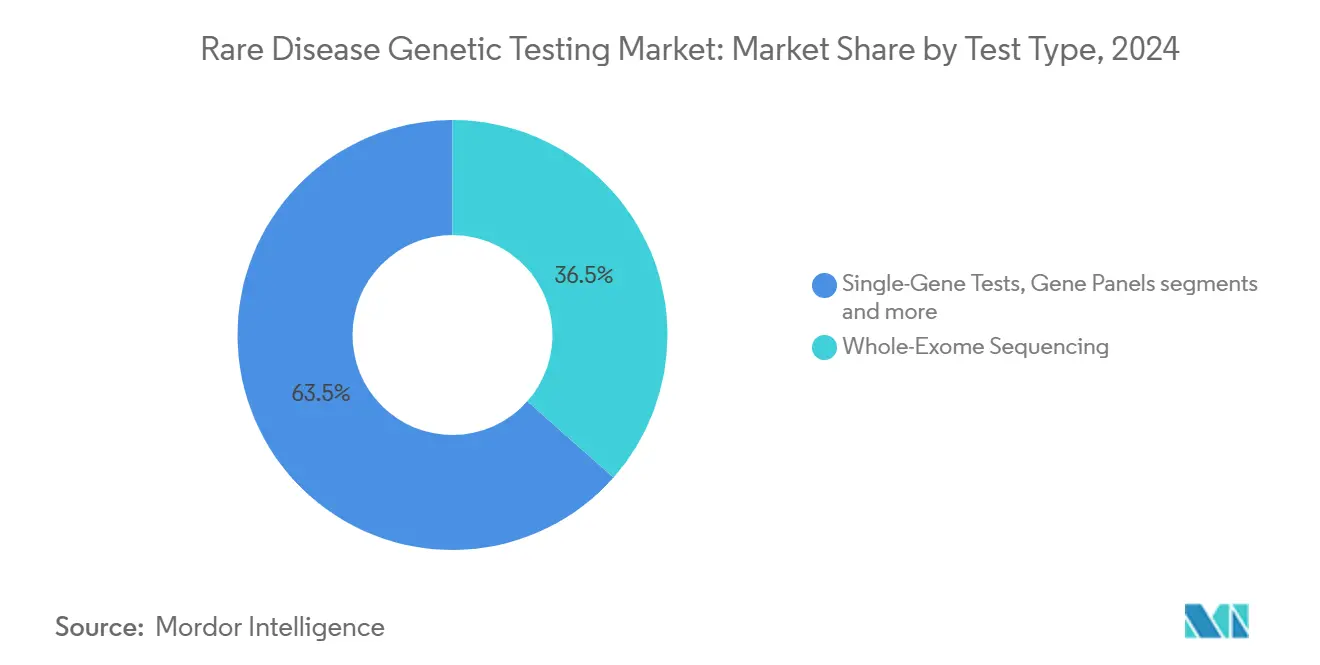
Note: Segment shares of all individual segments available upon report purchase
By Technology: Next-Generation Sequencing Platforms Evolve Rapidly
Short-read NGS captured 72.34% revenue during 2024, but long-read platforms are trending up at 16.35% CAGR thanks to structural-variant sensitivity. Sanger sequencing retains utility for variant confirmation, especially when laboratories require orthogonal validation.
Technology convergence accelerates. Illumina’s NovaSeq X now integrates single-flow-cell chips and AI-driven base-calling, cutting per-sample run time while lifting raw accuracy. Portable devices such as MinION bring near-lab quality to field sites, broadening geographic reach. As accuracy gaps narrow, cost curves favor holistic multi-omic platforms, expanding the rare disease genetic testing market size across hospital tiers and regional laboratories.
By Sample Type: Non-Invasive Collection Methods Gain Momentum
Blood samples still supply 58.46% of 2024 volume, prized for high DNA integrity. Nonetheless, saliva and buccal swabs are advancing 14.89% annually on patient comfort and room-temperature logistics. Volumetric absorptive microsampling now ships dried blood spots in paper envelopes without cold chain, making community-based programs viable.
Buccal DNA often outperforms blood for mitochondrial heteroplasmy detection and removes phlebotomy scheduling hurdles. FDA-cleared OrageneDx kits unlock at-home sample collection for clinical-grade tests. These innovations ensure sample diversity, reduce no-show rates, and enlarge overall throughput for the rare disease genetic testing market.
By Indication: Neurological Disorders Lead Complex Diagnostic Landscape
Neurological disorders accounted for 31.23% of 2024 revenue and are growing at 16.21% CAGR, buoyed by gene-therapy pipelines for conditions such as spinal muscular atrophy and Duchenne muscular dystrophy. Metabolic syndromes remain significant via newborn screening mandates that rely on rapid sequencing to guide enzyme replacement.
The neurological category benefits from AI phenotype-genotype matching that trims interpretation time for epilepsy panels and movement-disorder genomes. Early diagnosis determines eligibility for adeno-associated virus therapies, creating direct reimbursement incentives. These clinical drivers reinforce segment leadership and sustain momentum for the wider rare disease genetic testing market size.
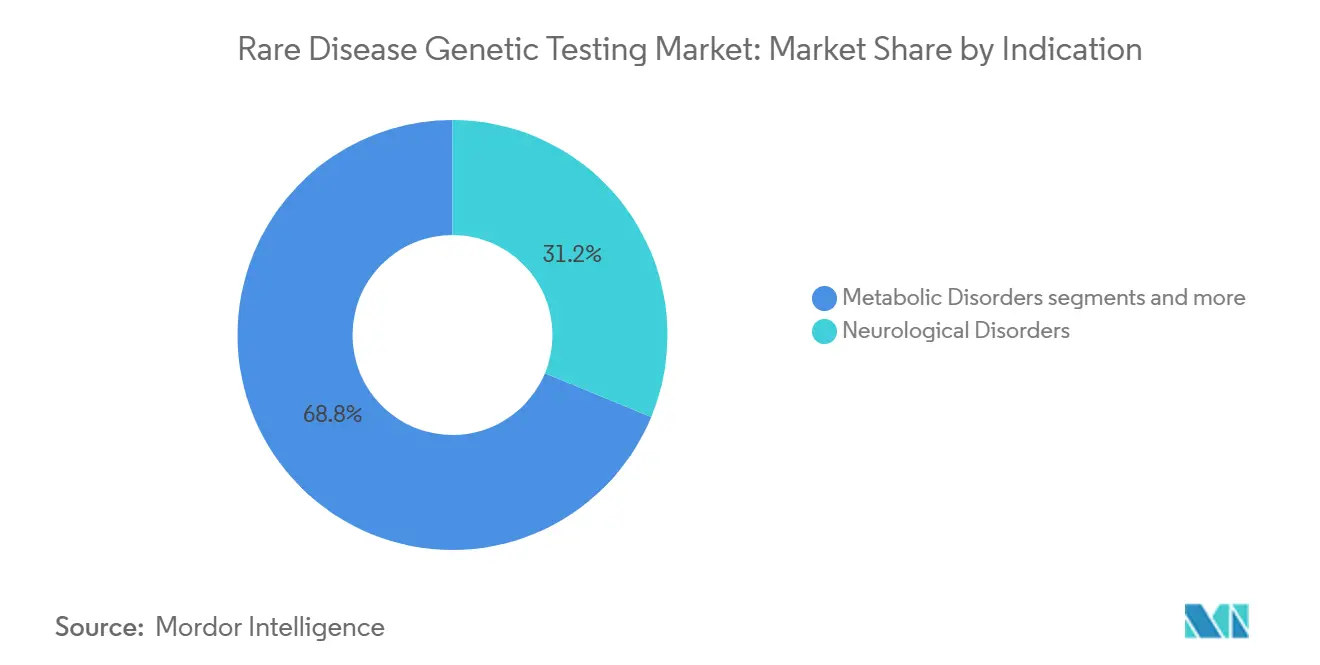
Note: Segment shares of all individual segments available upon report purchase
By End User: Healthcare System Integration Accelerates Adoption
Hospitals and clinics held 46.45% of 2024 revenue thanks to EHR integration, while direct-to-consumer channels are surging at 17.35% CAGR. Diagnostic laboratories supply complex bioinformatics pipelines for community hospitals that lack the necessary infrastructure.
Epic’s embedded ordering module for GeneDx rapid genome tests exemplifies frictionless workflows that embed genetics into acute care. Meanwhile, subscription-based consumer offerings extend optional clinical confirmation, bringing incremental demand from wellness-focused users and creating a two-tier flow of samples into the rare disease genetic testing market.
Geography Analysis
North America, with 43.23% share in 2024, benefits from broad payer coverage, payer-funded NICU sequencing, and clear FDA pathways that tie diagnostics to recently approved gene therapies[2]Source: U.S. Food and Drug Administration, “Advisory Committee; Genetic Metabolic Diseases Advisory Committee; Addition to List of Standing,” Federal Register, federalregister.go
. Whole-genome reimbursement for critically ill infants lowers barriers across state Medicaid programs and drives steady case volumes into regional reference labs.
Asia-Pacific posts the highest growth, advancing at 16.45% CAGR on national registries and subsidized testing in India and China ijbscience.in. Local manufacturers develop cost-effective reagents, while portable sequencers circumvent infrastructure gaps. Government consortiums negotiate bulk pricing, making genome tests affordable for provincial hospitals and amplifying the rare disease genetic testing market footprint.
Europe sustains mid-teen growth under the European Health Data Space, which mandates interoperable health records. Germany’s Digital Act simplifies cross-border data transfers, enhancing multi-country trial recruitment. Although reimbursement varies, pan-EU data pooling increases diagnostic odds for ultra-rare variants. Latin America and the Middle East remain nascent but leverage pilot programs such as Brazil’s Rare Genomes Project to highlight unmet need and justify new funding streams.
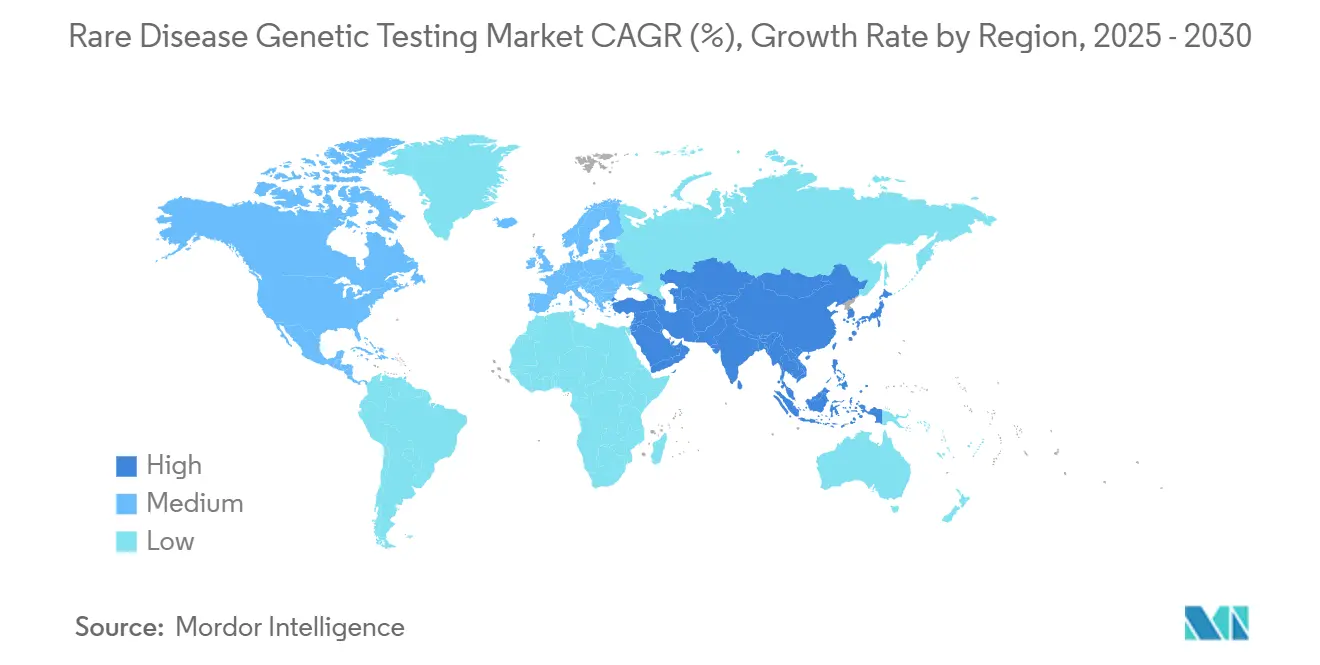
Competitive Landscape
The landscape is moderately consolidated. Diagnostics conglomerates leverage automation and global logistics, while specialty companies curate deep phenotype-linked biobanks. Labcorp’s USD 239 million purchase of Invitae assets and Regeneron’s USD 256 million acquisition of 23andMe illustrate convergence of testing and drug discovery. Illumina expands into multi-omics, threatening single-platform rivals, whereas Oxford Nanopore pushes long-read accuracy forward, challenging short-read incumbents.
Strategic alliances are pivotal. CENTOGENE licenses data to pharma partners, turning static reports into recurring fee streams. GeneDx employs revenue-share models that finance no-cost diagnostic programs, channeling higher sample volumes. Regulatory tightening around laboratory-developed tests in the United States raises compliance costs, favoring firms with robust quality systems and potentially consolidating the rare disease genetic testing industry around well-capitalized players.
Rare Disease Genetic Testing Industry Leaders
-
Quest Diagnostics Incorporated
-
Invitae Corporation
-
3billion Inc.
-
Eurofins Scientific, Inc.
-
Centogene N.V.
- *Disclaimer: Major Players sorted in no particular order
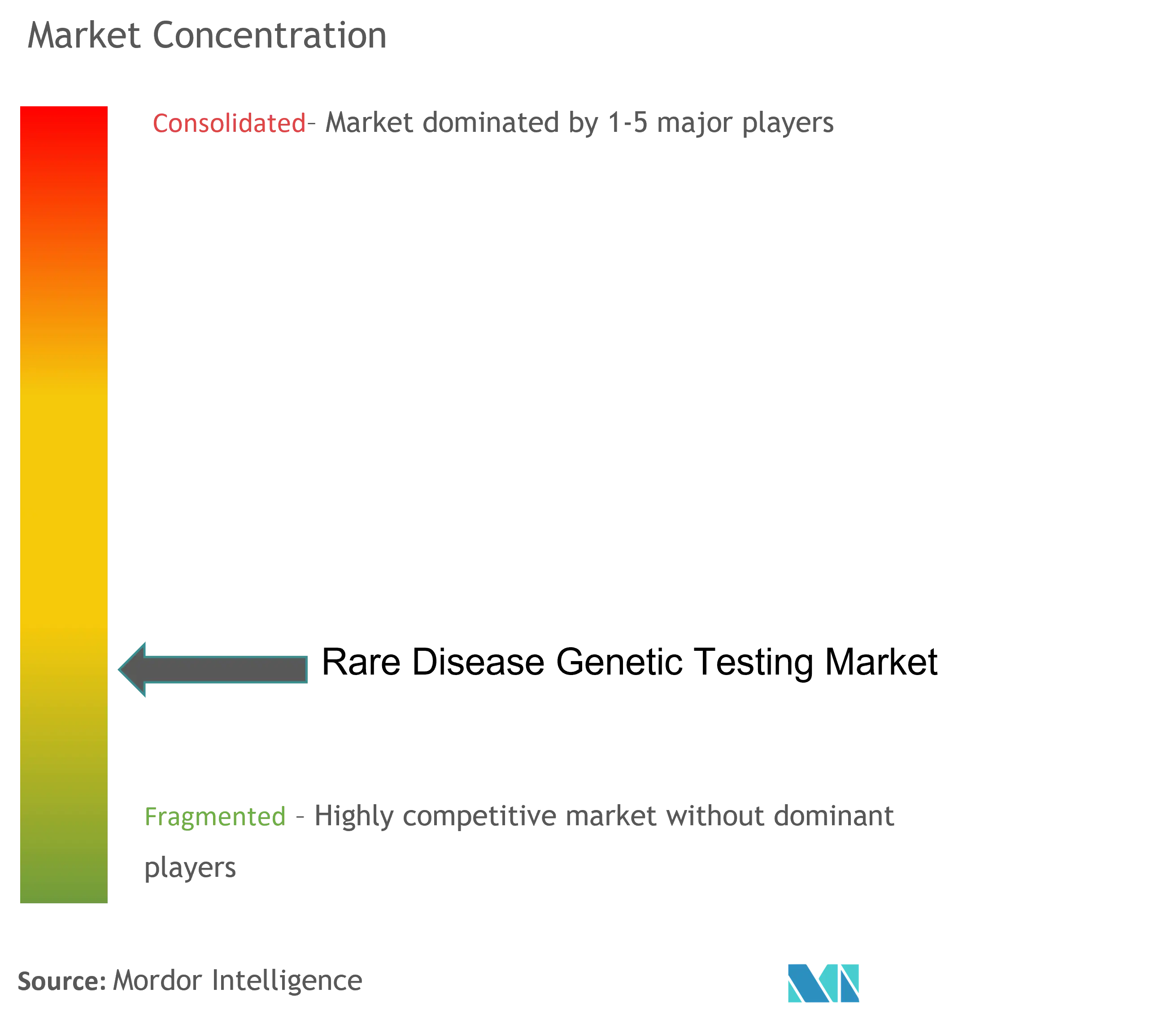
Recent Industry Developments
- March 2025: Regeneron closed its USD 256 million acquisition of 23andMe, adding a 15 million-person genetic dataset
- January 2025: Illumina released NovaSeq X single-flow-cell upgrades and 25B cycle kits for rare disease sequencing
Global Rare Disease Genetic Testing Market Report Scope
As per the scope of the report, rare diseases are genetic disorders, and genetic testing is an advanced diagnostic tool that gives results within weeks.
The rare disease genetic testing market is expected to register a CAGR of 10% over the forecast period. The rare disease genetic testing market is segmented by technology (next-generation sequencing, array technology, PCR-based testing, FISH, and other technologies), disease (neurological disorders, immunological disorders, hematology diseases, endocrine and metabolism diseases, cancer, musculoskeletal disorders, and other diseases), end user (clinics/hospitals, diagnostic laboratories, and other end users), and geography (North America, Europe, Asia-Pacific, Middle East and Africa, and South America). The market report also covers the estimated market sizes and trends for 17 countries across major regions globally. The report offers the value (in USD million) for the above segments.
| Single-Gene Tests |
| Gene Panels |
| Whole-Exome Sequencing |
| Whole-Genome Sequencing |
| Next-Generation Sequencing |
| Sanger Sequencing |
| PCR-Based Testing |
| Blood |
| Saliva/Buccal Swab |
| Amniotic/Chorionic (Prenatal) |
| Neurological Disorders |
| Metabolic Disorders |
| Immunological & Hematological Disorders |
| Others |
| North America | United States |
| Canada | |
| Mexico | |
| Europe | Germany |
| United Kingdom | |
| France | |
| Italy | |
| Spain | |
| Rest of Europe | |
| Asia-Pacific | China |
| India | |
| Japan | |
| South Korea | |
| Australia | |
| Rest of Asia-Pacific | |
| South America | Brazil |
| Argentina | |
| Rest of South America | |
| Middle East and Africa | GCC |
| South Africa | |
| Rest of Middle East and Africa |
| By Test Type (Value) | Single-Gene Tests | |
| Gene Panels | ||
| Whole-Exome Sequencing | ||
| Whole-Genome Sequencing | ||
| By Technology (Value) | Next-Generation Sequencing | |
| Sanger Sequencing | ||
| PCR-Based Testing | ||
| By Sample Type (Value) | Blood | |
| Saliva/Buccal Swab | ||
| Amniotic/Chorionic (Prenatal) | ||
| By Indication (Value) | Neurological Disorders | |
| Metabolic Disorders | ||
| Immunological & Hematological Disorders | ||
| Others | ||
| By Geography (Value) | North America | United States |
| Canada | ||
| Mexico | ||
| Europe | Germany | |
| United Kingdom | ||
| France | ||
| Italy | ||
| Spain | ||
| Rest of Europe | ||
| Asia-Pacific | China | |
| India | ||
| Japan | ||
| South Korea | ||
| Australia | ||
| Rest of Asia-Pacific | ||
| South America | Brazil | |
| Argentina | ||
| Rest of South America | ||
| Middle East and Africa | GCC | |
| South Africa | ||
| Rest of Middle East and Africa | ||
Key Questions Answered in the Report
What underpins the 14.23% CAGR of the rare disease genetic testing market?
Declining NGS costs, AI-driven interpretation, and expanding reimbursement combine with gene-therapy demand to propel sustained double-digit growth.
How do regulatory changes shape market consolidation?
FDA oversight of laboratory-developed tests raises compliance costs, giving well-capitalized firms an edge, while the EU Health Data Space unlocks cross-border data access for smaller players.
Which technology will lead future adoption?
Long-read sequencing is gaining share thanks to structural variant detection and portability, yet improved short-read accuracy maintains a dual-technology landscape.
Why is Asia-Pacific the fastest-growing region?
Government-funded registries, subsidy programs, and domestic reagent production lower testing costs and expand access across populous nations.
Which region has the biggest share in Rare Disease Genetic Testing Market?
In 2025, the North America accounts for the largest market share in Rare Disease Genetic Testing Market.
Page last updated on:
